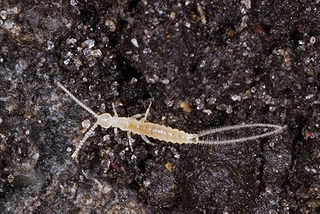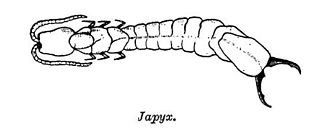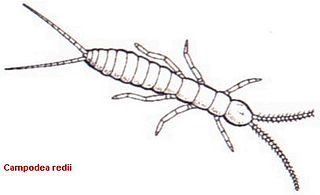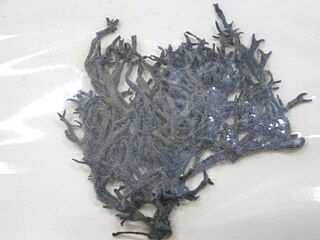See also
- Dipleura , a genus of trilobite
| This disambiguation page lists articles about taxa associated with the same name. If an internal link led you here, you may wish to change the link to point directly to the intended article. |
Diplura , "two-pronged bristletails", is an order of hexapods closely related to insects
Diplura may also refer to:
| This disambiguation page lists articles about taxa associated with the same name. If an internal link led you here, you may wish to change the link to point directly to the intended article. |

The order Diplura is one of three orders within the class Entognatha. The name "diplura", or "two tails", refers to the characteristic pair of caudal appendages or filaments at the terminal end of the body.

The family Dipluridae, known as curtain-web spiders are a group of spiders in the infraorder Mygalomorphae, that have two pairs of booklungs, and chelicerae (fangs) that move up and down in a stabbing motion. A number of genera, including that of the Sydney funnel-web spider (Atrax), used to be classified in this family but have now been moved to Hexathelidae.

The Japanese spider crab is a species of marine crab that lives in the waters around Japan. It has the largest leg span of any arthropod. These giants go through three main larval stages along with a prezoeal stage in order to grow to their great size.The genus Macrocheira contains multiple species. Two fossil species belonging to this genus have been found, Macrocheira ginzanensis and Macrocheira yabei, both from the Miocene of Japan. The diverse taxonomic history is an important part of what these creatures are and how they evolved to be what they are today. These creatures are not isolated however, as they are the subject of fishery and are considered a delicacy. To prevent overfishing, conservation efforts are being put forth for to protect these creatures and their population from the dangers of overfishing.

The japygids are a taxon of hexapods, of the order Diplura. In this family, the paired cerci at the end of their abdomens are pincer-like and are used to catch their tiny prey. Seventy genera are recognised, divided among seven subfamilies.

Campodea is a genus of small, white, bristle-tailed arthropods in the order Diplura. The best known species, Campodea staphylinus, has a wide distribution across much of Europe. It lives in damp places under stones, fallen trees, or in rotten wood and leaves. There are at least 130 described species in Campodea.
Diplura is a genus of South American curtain web spiders that was first described by C. L. Koch in 1850. It is found in South America and Cuba belonging to the subfamily Diplurinae. They possess a lyra on their prolateral maxillae. Diplura species can be distinguished from Trechona sp. by the number of setae on this lyra. They differ from Harmonicon sp. by the leg formula and the shape of the lyra bristles.

The Campodeidae are a family of hexapods belonging to the order Diplura. These pale, eyeless hexapods, the largest of which grow to around 12 mm in length, can be recognised by the two long, many-segmented cerci at the end of the abdomen. Abdominal spiracles are absent.

Megarachne is a genus of eurypterid, an extinct group of aquatic arthropods. Fossils of Megarachne have been discovered in deposits of Late Carboniferous age, from the Gzhelian stage, in San Luis, Argentina. The fossils of the single and type species M. servinei have been recovered from deposits that had once been a freshwater environment. The generic name, composed of the Ancient Greek μέγας (megas) meaning "great" and Ancient Greek ἀράχνη (arachne) meaning "spider", translates to "great spider", because the fossil was misidentified as a large prehistoric spider.

Ishigeales is an order of brown algae. It includes two families, Ishigeaceae and Petrodermataceae. The genus Diplura is also included, but not placed to family.
Hapljapyx is a genus of diplurans in the family Japygidae.
Parajapygidae is a family of hexapods in the order Diplura.
The Projapygidae are a family of hexapods in the order Diplura.

Spiders are air-breathing arthropods that have eight legs, chelicerae with fangs able to inject venom, and spinnerets that extrude silk. They are the largest order of arachnids and rank seventh in total species diversity among all orders of organisms. Spiders are found worldwide on every continent except for Antarctica, and have become established in nearly every habitat with the exceptions of air and sea colonization. As of July 2019, at least 48,200 spider species, and 120 families have been recorded by taxonomists. However, there has been dissension within the scientific community as to how all these families should be classified, as evidenced by the over 20 different classifications that have been proposed since 1900.

The Tryonicidae are a family of cockroaches.

Diplura lineata is a species of funnel-web tarantulas belonging to the subfamily Diplurinae. This species can be found in Venezuela and Brazil.
Turkmenicampa mirabilis is a species of small, white, bristle-tailed arthropod in the order Diplura. It is found from Lebap Region in Turkmenistan.

Rhabdura is a suborder of two-pronged bristletails in the order Diplura. There are about 5 families and more than 290 described species in Rhabdura.